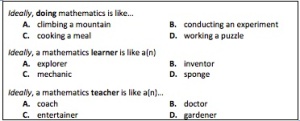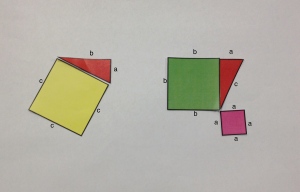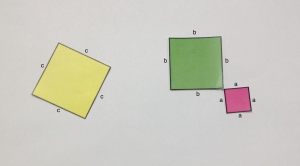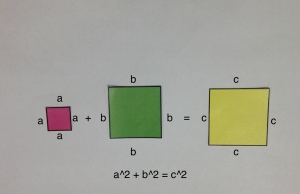Recently I got the chance to observe another math teacher at my placement and see what their approach to teaching math is and think about how this style is influenced by their beliefs. I had the teacher that I observed answer the following questions about what they think it means to do math.
 The teachers that I observed said that doing mathematics is like working a puzzle, a mathematics learner is like an explorer, and a mathematics teacher is like a coach. The day that I observed the class was doing a review day for an upcoming quiz. The review was set up so that each student had a whiteboard and did problems that the teacher gave. They were working in pairs that provided support for students to work together if they got stuck or a way for them to check to make sure that they got the right answers. As they finished their work students would raise their whiteboards for the teacher to check them and give them either a “yes you got it” or a “nope you didn’t get it yet”. There was one question in particular that a lot of students were getting wrong and the teacher started sharing whiteboards from groups that had the correct answer and having other students going to other groups to help them solve the problems and understand what they should be doing and what they were doing wrong.
The teachers that I observed said that doing mathematics is like working a puzzle, a mathematics learner is like an explorer, and a mathematics teacher is like a coach. The day that I observed the class was doing a review day for an upcoming quiz. The review was set up so that each student had a whiteboard and did problems that the teacher gave. They were working in pairs that provided support for students to work together if they got stuck or a way for them to check to make sure that they got the right answers. As they finished their work students would raise their whiteboards for the teacher to check them and give them either a “yes you got it” or a “nope you didn’t get it yet”. There was one question in particular that a lot of students were getting wrong and the teacher started sharing whiteboards from groups that had the correct answer and having other students going to other groups to help them solve the problems and understand what they should be doing and what they were doing wrong.
After watching the review activity and looking over the answers to the above questions the way that the class session was run made so much more sense. I can see the idea of working a puzzle come through when the teacher was explaining how to find surface area and volume of prisms. He talked about identifying what the question was asking and then to identify what information was needed to solve for what it was asking. I think this speaks to solving a puzzle because those two things are key in solving any puzzle. When I saw him giving whiteboards to struggling students to help them solve the problem I was unsure about how it was going to play out and if it would just lead to students copying their peers work so they could get the right answer. (After watching I didn’t get any indication that this was happening.) I think this strategy fits well with the way that this teacher views learners as explorers. From my observations giving the students the whiteboard was a way for them to explore what they did wrong and what misconceptions they have by seeing what others did and then to discover what they should be doing. Lastly when observing the overall teaching style for this class session the coach persona seemed to fit well with how this teacher was teaching. The approach seemed to be to give students everything they need to solve the problem but ultimately it is up to the student to solve the problem. When these needs varied by students and he adjusted to what the particular student needed to be successful.
After the observation it became much clearer how our beliefs about teaching impact the way we teach. If I were to have observed this lesson without asking the questions that I did I think I would have had a much different view on what I had seen. However, by seeing what beliefs this teacher had about teaching math gave me a clearer lens into why he teaches the way he does and even gave me a few ideas that I may not have thought about before because our views on teaching are different.









